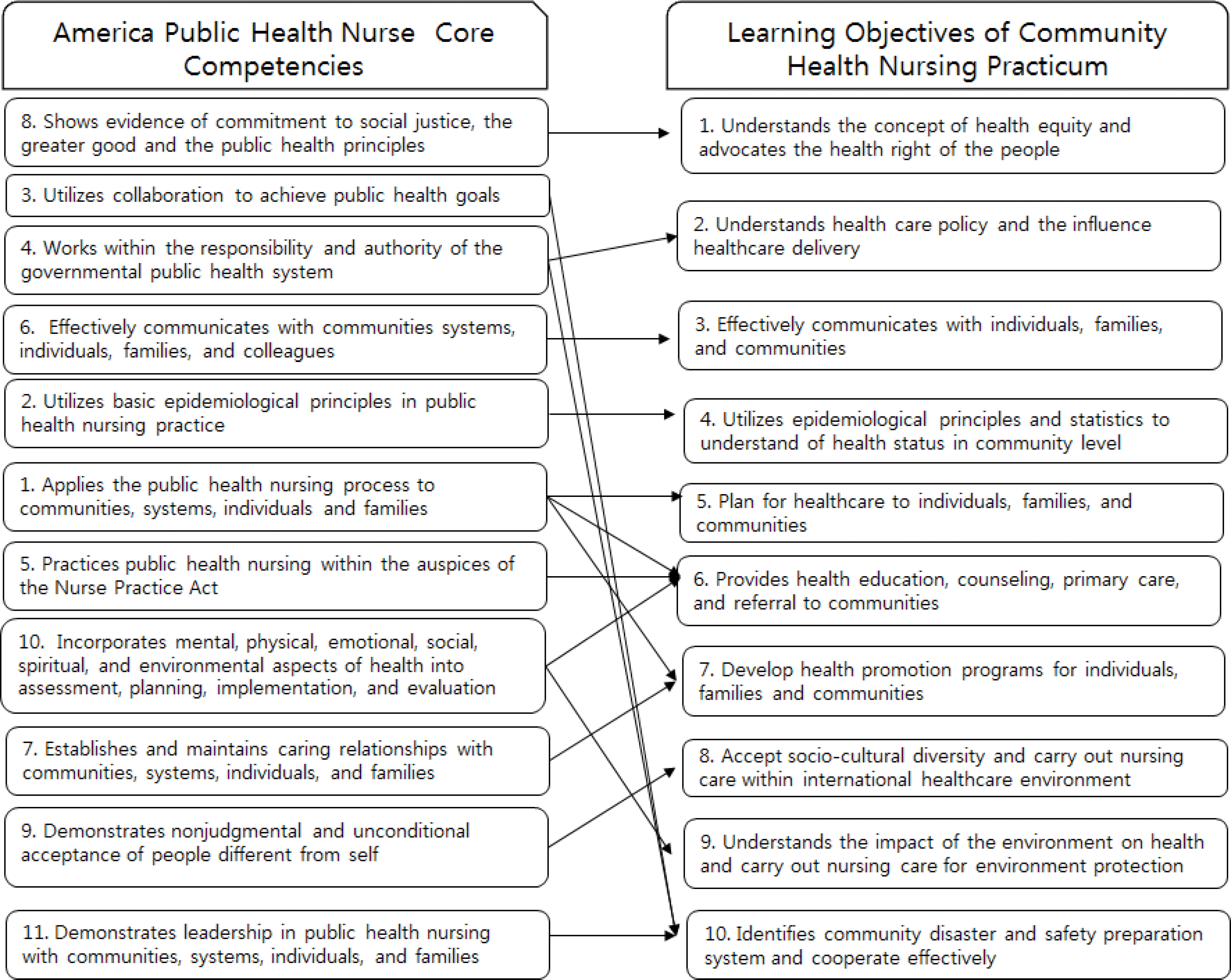Abstract
Purpose
This study attempts to examine the extent to which competencies were identified in a Korean community nursing practice based on the 11 core competencies required by US health nurses.
Methods
This was a descriptive research study, and the subjects of this study were 11 students who were in a four-year nursing course. Data were collected by means of a questionnaire from October 19 to November 22, 2016.
Results
Core competencies in total were practiced in 60.0% to 98.5% of schools in Korea. Among these, competencies corresponding to the practice level of ‘high’ were identified as ‘communicating effectively with community nursing subjects and colleagues, and accepting various personal characteristics without criticism or prejudice’. On the other hand, competencies corresponding to the practice level of ‘low’ were identified as ‘to comply with social justice, public good, public health principles, and leadership in a community nursing practice’.
Conclusion
This study can be used as a resource to categorize the competence of nursing students expected in the field of community nursing. Based on a careful review of core competencies with low practice, it is necessary to seek specific practical strategies to strengthen these competencies in the future.
Go to : 
References
1. Lee CY, Lee HY, Kim GS, Kang KA. Current status of community health nursing practicum in bachelor program in Korea. Journal of Korean Academy of Community Health Nursing. 2006; 17(1):26–37.
2. Kwon IS. An analysis of research on clinical nursing education. Journal of Korean Academy of Nursing. 2002; 32(5):706–715.

3. Clark MJ. Community health nursing advocacy for population health. 5th ed. New Jersey: Pearson Prentice Hall;2008. p. 1064.
4. Chin YR, Kim H. The role of community health nurse in assay written by a nurse practitioner of primary health care post. Journal of Korean Public Health Nursing. 2016; 30(2):300–310. https://doi.org/10.5932/JKPHN.2016.30.2.300.

5. Kang SY, Kim KH, Kim KS, Park IS, Park HS, Sea YO, et al. A study on the Korean nurse's job analysis and national nurses licensing examination. Seoul: Korea Health Personnel Licens- ing Examination Institute;2016. p. 312.
6. So KH. Competency in the context of schooling: It's meaning and curricular implications. The Journal of Curriculum Studies. 2007; 25(3):1–21.
7. Ko JK, Chung MS, Choi MA, Park YI, Bang KS, Kim JA, et al. Modeling of nursing competencies for competency-based curriculum development. The Journal of Korean Academic Society of Nursing Education. 2013; 19(1):87–96. https://doi.org/10.5977/jkasne.2013.19.1.87.

8. Garcia CM, Schaffer MA, Schoon PM. Population based public health clinical manual. 2nd ed. Indianapolis: Sigma Theta Tau International;2014. p. 468.
9. Kim YS, Lee HS, Shin AK. Classifications of institutional objectives of elementary science based of Bloom's revised taxonomy of educational objectives. Elementary Science Education. 2007; 26(5):570–579.
10. Korean Accreditation Board of Nursing Education. Nursing education accreditation [Internet]. Seoul: Korean Accreditation Board of Nursing Education;2014. [cited 2017 March 1]. Available from:. http://kabone.or.kr/kabon02/index.php.
11. Ahn YH, Kweon EK, Choi ES, Gu EJ. Effects of competency level in communication on professional competence of public health nurses. Journal of Korean Public Health Nursing. 2011; 25(2):233–243.
12. Bae SH, Park JS. The recognition of achievement and importance of nursing program outcome among nursing students. The Journal of Korean Academic Society of Nursing Education. 2013; 19(1):203–214.

13. Boschma G, Einboden R, Groening M, Jackson C, MacPhee M, Marshall H, et al. Strengthening communication education in an undergraduate nursing curriculum. International Journal of Nursing Education Scholarship. 2010; 7(1):28–41.

14. Son HM, Kim HS, Koh MH, Yu SJ. Analysis of the communica- tion education in the undergraduate nursing curriculum of Korea. The Journal of Korean Academic Society of Nursing Education. 2011; 17(3):424–432.
15. Chae MJ, Kim JI, Lee JH. Effects of a multicultural course on the multicultural acceptability. The Journal of Korean Academic Society of Nursing Education. 2015; 21(3):373–381.
16. World Health Organization. The world health report: Working together for health [Internet]. Geneva: World Health Organization;2006. [cited 2017 May 28]. Available from:. http://www.who.int/iris/bitstream/10665/43432/1/9241563176_eng.pdf.
17. Freeman LH, Voignier RR, Scott DL. New curriculum for a new century: Beyond repackaging. Educational Innovations. 2002; 14(1):38–40.

18. Lee HS, Kim JK. Relationship among communication competence, communication types, and organizational commitment in hospital nurses. Journal of Korean Academy of Nursing Administration. 2010; 16(4):488–496.

19. Park JM, Kim CS, Kim JH, An JY, Pyo EY. Strategy for improving core nursing competency-based education. The Journal of Korean Academic Society of Nursing Education. 2015; 21(3):426–439.

20. June KJ, Chin YR, Kim HG, Kim CM, Song YY, Kim SY, et al. Direction of the community health nursing practice education focusing on the nursing education accreditation criteria. Journal of Korean Academy of Community Health Nursing. 2016; 27(2):183–192. https://doi.org/10.12799/jkachn.2016.27.2.183.

Go to : 




 PDF
PDF ePub
ePub Citation
Citation Print
Print



 XML Download
XML Download